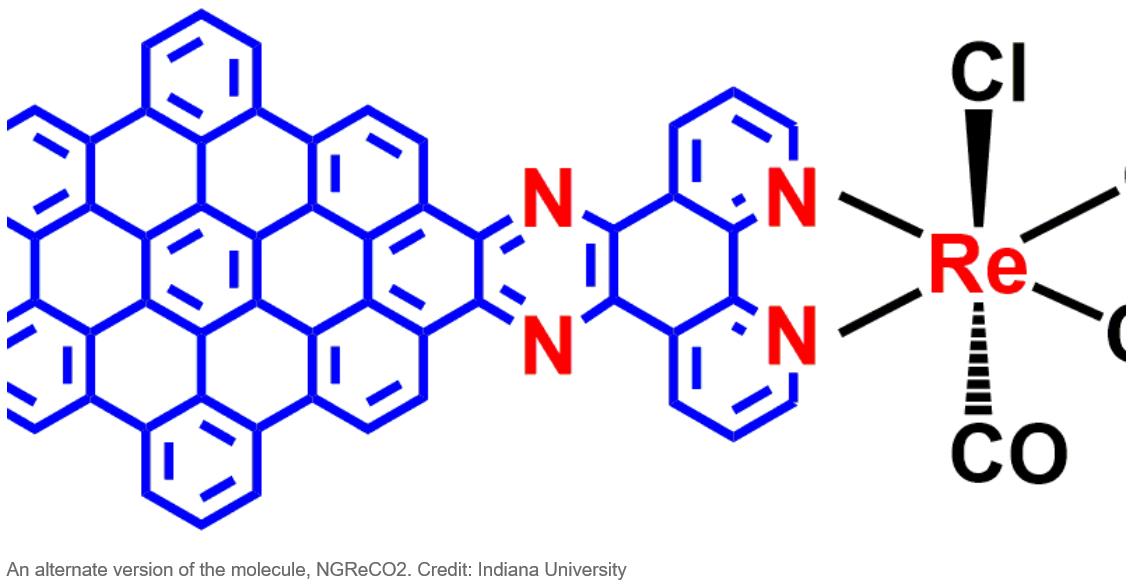博文
JACS:化学家创建分子“叶片”,将CO2有效转化为CO(附原文)
 精选
精选
|||
JACS:化学家创建分子“叶片”,将CO2有效转化为CO(附原文)
诸平
据物理学家组织网(Phys.org)2017年3月8日报道,美国印第安纳大学(Indiana University)的化学家已经创建了一种分子“叶片”,其功能像普通的植物叶片一样,利用太阳光就可以将大气中的温室效应气体CO2,转化为具有广泛应用前景的CO。众所周知,CO被氧化形成CO2会产生大量的能力,而要想将CO2再转化为CO同样需要大量能量,然而,植物叶片的光合作用则轻而易举地将CO2还原为CO,并释放出氧气。印第安纳大学(Indiana University)的乔潇潇(Xiaoxiao Qiao音译)等人,他们利用纳米石墨烯-铼(Re)形成的配合物分子与二吡啶(bipyridine)连接,可以使CO2的还原反应高效顺利进行,将其转换成CO。其实,此“叶片”主要由2部分组成,其中纳米石墨烯部分就是太阳能捕获器,吸收太阳能;而其中的铼原子就是产生CO的“引擎”。纳米石墨烯捕获到的太阳能来驱动铼原子的电子流向CO2,使其转化为稳定的CO。更多信息请浏览下面的相关报道或者浏览原文。
Chemists create molecular 'leaf' that collects and stores solar power without solar panels
March 8, 2017

An international team of scientists led by Liang-shi Li at Indiana University has achieved a new milestone in the quest to recycle carbon dioxide in the Earth's atmosphere into carbon-neutral fuels and others materials.
The chemists have engineered a molecule that uses light or electricity to convert the greenhouse gas carbon dioxide into carbon monoxide—a carbon-neutral fuel source—more efficiently than any other method of "carbon reduction."
The process is reported today in the Journal of the American Chemical Society.
"If you can create an efficient enough molecule for this reaction, it will produce energy that is free and storable in the form of fuels," said Li, associate professor in the IU Bloomington College of Arts and Sciences' Department of Chemistry. " This study is a major leap in that direction."
Burning fuel—such as carbon monoxide—produces carbon dioxide and releases energy. Turning carbon dioxide back into fuel requires at least the same amount of energy. A major goal among scientists has been decreasing the excess energy needed.
This is exactly what Li's molecule achieves: requiring the least amount of energy reported thus far to drive the formation of carbon monoxide. The molecule—a nanographene-rhenium complex connected via an organic compound known as bipyridine—triggers a highly efficient reaction that converts carbon dioxide to carbon monoxide.
 The ability to efficiently and exclusively create carbon monoxide is significant due to the molecule's versatility.
The ability to efficiently and exclusively create carbon monoxide is significant due to the molecule's versatility.
"Carbon monoxide is an important raw material in a lot of industrial processes," Li said. "It's also a way to store energy as a carbon-neutral fuel since you're not putting any more carbon back into the atmosphere than you already removed. You're simply re-releasing the solar power you used to make it."
The secret to the molecule's efficiency is nanographene—a nanometer-scale piece of graphite, a common form of carbon (i.e. the black "lead" in pencils)—because the material's dark color absorbs a large amount of sunlight.
Li said that bipyridine-metal complexes have long been studied to reduce carbon dioxide to carbon monoxide with sunlight. But these molecules can use only a tiny sliver of the light in sunlight, primarily in the ultraviolet range, which is invisible to the naked eye. In contrast, the molecule developed at IU takes advantage of the light-absorbing power of nanographene to create a reaction that uses sunlight in the wavelength up to 600 nanometers—a large portion of the visible light spectrum.
Essentially, Li said, the molecule acts as a two-part system: a nanographene "energy collector" that absorbs energy from sunlight and an atomic rhenium "engine" that produces carbon monoxide. The energy collector drives a flow of electrons to the rhenium atom, which repeatedly binds and converts the normally stable carbon dioxide to carbon monoxide.
The idea to link nanographene to the metal arose from Li's earlier efforts to create a more efficient solar cell with the carbon-based material. "We asked ourselves: Could we cut out the middle man—solar cells—and use the light-absorbing quality of nanographene alone to drive the reaction?" he said.
Next, Li plans to make the molecule more powerful, including making it last longer and survive in a non-liquid form, since solid catalysts are easier to use in the real world. He is also working to replace the rhenium atom in the molecule—a rare element—with manganese, a more common and less expensive metal.
Explore further: Scientists solve puzzle of converting gaseous carbon dioxide to fuel
More information: Xiaoxiao Qiao, Qiqi Li, Richard N. Schaugaard, Benjamin W. Noffke, Yijun Liu , Dongping Li, Lu Liu, Krishnan Raghavachari , and Liang-shi Li. Well-Defined Nanographene–Rhenium Complex as an Efficient Electrocatalyst and Photocatalyst for Selective CO2 Reduction(点击可以免费下载原文). Journal of the American Chemical Society. (2017). DOI:10.1021/jacs.6b12530
Abstract

Improving energy efficiency of electrocatalytic and photocatalytic CO2 conversion to useful chemicals poses a significant scientific challenge. We report on using a colloidal nanographene to form a molecular complex with a metal ion to tackle this challenge. In this work, a well-defined nanographene–Re complex was synthesized, in which electron delocalization over the nanographene and the metal ion significantly decreases the electrical potential needed to drive the chemical reduction. We show the complex can selectively electrocatalyze CO2 reduction to CO in tetrahydrofuran at −0.48 V vs NHE, the least negative potential reported for a molecular catalyst. In addition, the complex can absorb a significant spectrum of visible light to photocatalyze the chemical transformation without the need for a photosensitizer.
https://blog.sciencenet.cn/blog-212210-1039047.html
上一篇:纳米酶:有望成为有机磷毒剂毒性之克星(附原文)
下一篇:鲍哲楠:开发出似橡胶的塑料电极(附原文)